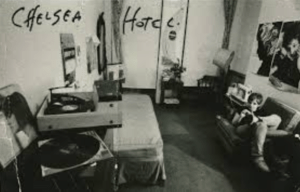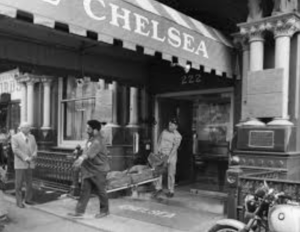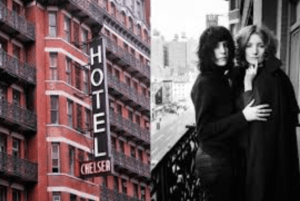
“I didn’t really want to leave the Chelsea, its identification with poets and writers, Harry, and our bathroom in the hall. We talked about it a lot. I would have the smaller space in the front, and he would have the back. The money we saved would pay for the utilities. I knew it was a more practical thing to do, even an exciting prospect. We would both have our space to do our work and be close to one another. But it was also very sad, especially for me. I loved living in the hotel, and I knew when we left everything would change” (Smith 145).
 Throughout the third chapter of Patti Smith’s Just Kids (2010), entitled “Hotel Chelsea”, the Chelsea Hotel becomes an emblem of artistry and originality on a personal level as well as a social landmark of creativity within Smith’s community. This community is a smaller, scaled down version of the congregation of artists that she is a part of within New York City. Without her or Robert’s artwork, neither of them would have even been able to live at the Chelsea Hotel. She utilized Robert’s and her portfolios as a sort of security deposit for their small room (94). Their art is what granted them access to this aesthetic mecca and introduced them to their inspirational fellow residents. Furthermore, Smith consistently refers to the Chelsea Hotel as her home and discusses how she felt like “the lobby was an extension of the room” in which she was residing (120). A saying that is often shared in New York City that says something along the lines of “your apartment is where you sleep and the city is your living room”, bears a similar idea that may help Smith’s readers better understand her ideas, hopes, and fears about her community. Her unique version of “home” had multiple important layers. The first, most central layer, was the small one-bed room she shared with Robert in the Chelsea where Smith claimed that they both
Throughout the third chapter of Patti Smith’s Just Kids (2010), entitled “Hotel Chelsea”, the Chelsea Hotel becomes an emblem of artistry and originality on a personal level as well as a social landmark of creativity within Smith’s community. This community is a smaller, scaled down version of the congregation of artists that she is a part of within New York City. Without her or Robert’s artwork, neither of them would have even been able to live at the Chelsea Hotel. She utilized Robert’s and her portfolios as a sort of security deposit for their small room (94). Their art is what granted them access to this aesthetic mecca and introduced them to their inspirational fellow residents. Furthermore, Smith consistently refers to the Chelsea Hotel as her home and discusses how she felt like “the lobby was an extension of the room” in which she was residing (120). A saying that is often shared in New York City that says something along the lines of “your apartment is where you sleep and the city is your living room”, bears a similar idea that may help Smith’s readers better understand her ideas, hopes, and fears about her community. Her unique version of “home” had multiple important layers. The first, most central layer, was the small one-bed room she shared with Robert in the Chelsea where Smith claimed that they both
 knew that “in the end [they] were better off together” (96). This was a very private atmosphere in which Smith was able to help nurse Robert back to health and where they worked on art before renting out more space for an art studio. The next, wider sector of Smith’s community is consisted of her fellow Chelsea Hotel residents. She describes the hotel as her “new university” since she learns so much while there from the books and poems her neighbors recommend that she reads (138). Some of the first of these important figures were fashion designer Bruce Rudow, artist Sandy Daley, and musician Matthew Reich (101-102). Included in this hotel community is the lobby that Smith thought of as part of her room. For Smith, and probably other artists who had stayed in the hotel, there was a special level of friendly intimacy and closeness in this particular living environment. Contrastingly, the final community is that of New York City in its entirety. This society of people was obviously much more unfamiliar to Smith which is partly why she had such a hard time parting from her hotel community out elsewhere in the city. The reality of leaving this home was clearly difficult for Smith to get used to. This is evident as the mood of this excerpt is hopeful for the future, yet very somber. Even before she leaves, it seems that Smith is yearning for the feelings of home and community that the Chelsea provided for her. She claims that “though [she] knew [they] would only be a few doors away from the hotel, [she] knew things would be different” (150). Although Smith and Robert would still be geographically very close to the hotel and their friends that lived there, there was still a new level of separation from their beloved single-building neighborhood, which is something that Smith has to deal with. She does, however, still have her core, familial community with Robert who, after everything they had been through together, can definitely be considered family to her. Despite leaving her residence in the Chelsea Hotel in the middle of the novel, not long after originally arriving there, the landmark became essential to Smith’s development as an artist since it was here, in this community, that she cut her hair, a seemingly simple action that ended up changing the way people viewed her and interacted with her, met many friends and inspirations, and partially matured to become the artist she was meant to be (140).
knew that “in the end [they] were better off together” (96). This was a very private atmosphere in which Smith was able to help nurse Robert back to health and where they worked on art before renting out more space for an art studio. The next, wider sector of Smith’s community is consisted of her fellow Chelsea Hotel residents. She describes the hotel as her “new university” since she learns so much while there from the books and poems her neighbors recommend that she reads (138). Some of the first of these important figures were fashion designer Bruce Rudow, artist Sandy Daley, and musician Matthew Reich (101-102). Included in this hotel community is the lobby that Smith thought of as part of her room. For Smith, and probably other artists who had stayed in the hotel, there was a special level of friendly intimacy and closeness in this particular living environment. Contrastingly, the final community is that of New York City in its entirety. This society of people was obviously much more unfamiliar to Smith which is partly why she had such a hard time parting from her hotel community out elsewhere in the city. The reality of leaving this home was clearly difficult for Smith to get used to. This is evident as the mood of this excerpt is hopeful for the future, yet very somber. Even before she leaves, it seems that Smith is yearning for the feelings of home and community that the Chelsea provided for her. She claims that “though [she] knew [they] would only be a few doors away from the hotel, [she] knew things would be different” (150). Although Smith and Robert would still be geographically very close to the hotel and their friends that lived there, there was still a new level of separation from their beloved single-building neighborhood, which is something that Smith has to deal with. She does, however, still have her core, familial community with Robert who, after everything they had been through together, can definitely be considered family to her. Despite leaving her residence in the Chelsea Hotel in the middle of the novel, not long after originally arriving there, the landmark became essential to Smith’s development as an artist since it was here, in this community, that she cut her hair, a seemingly simple action that ended up changing the way people viewed her and interacted with her, met many friends and inspirations, and partially matured to become the artist she was meant to be (140).